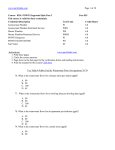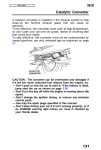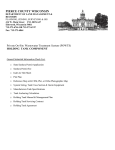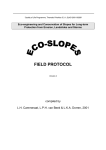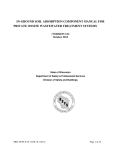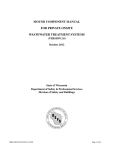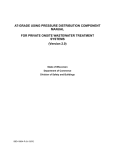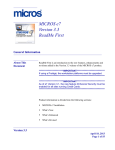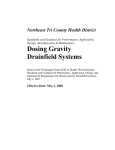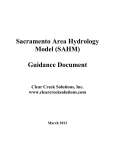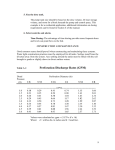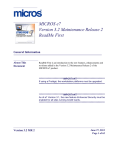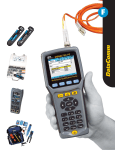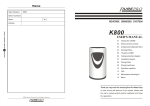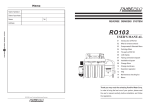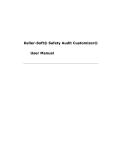Download RECIRCULATING SAND FILTER SYSTEM COMPONENT QUIZ
Transcript
www.garyklinka.com 1 of 19 RECIRCULATING SAND FILTER SYSTEM COMPONENT QUIZ 12 Hours of CEU credits for the following credentials: Powts Maintainer Powts Restricted Technology Installer registration Powts Inspector Journeyman Plumber-Restricted Service Journeyman Plumber Fee $99.00 Qualifier Powts Maintainer Soil Tester Master Plumber-Restricted Service Master Plumber Instructions: www.garyklinka.com 1. Print these pages. 2. Circle the correct answers and transfer to the answer sheet on the last page. 3. Page down to the last page for the verification forms and mailing instructions. 4. Download Manual-Click Here 1. 2. 3. 4. 5. INFLUENT FLOWS AND LOADS Table 1 The design wastewater flow (DWF) from one and two-family dwellings must be? A. < 2250 gal/per day B. < 150 gal/day/bedroom C. = Design wastewater flow (DWF) D. 150% of estimated wastewater flow in accordance with Table 4 of this manual or s. Comm 83.43 (6), Wis. Adm. Code The design wastewater flow (DWF) from primary treatment tanks must be? A. < 2250 gal/per day B. < 150 gal/day/bedroom C. = Design wastewater flow (DWF) D. 150% of estimated wastewater flow in accordance with Table 4 of this manual or s. Comm 83.43 (6), Wis. Adm. Code The design wastewater flow (DWF) from public facilities must be? A. < 2250 gal/per day B. < 150 gal/day/bedroom C. = Design wastewater flow (DWF) D. >150% of estimated wastewater flow in accordance with Table 4 of this manual or s. Comm 83.43 (6), Wis. Adm. Code The Forward flow must be? A. < 2250 gal/per day B. < 150 gal/day/bedroom C. = Design wastewater flow (DWF) D. >150% of estimated wastewater flow in accordance with Table 4 of this manual or s. Comm 83.43 (6), Wis. Adm. Code Distribution cell area per orifice size for a sand filter media tank must be? A. ≤ 2250 gal/per day B. ≤ 4 ft² C. ≥ 4 ft² D. ≤6 ft² www.garyklinka.com 6. Design loading rate (DLR) for a sand filter media tank must be? A. ≤ 5 gpd/ft2 based on forward flow B. ≤ 4 ft² C. ≥ 5 gpd/ft2 based on forward flow D. ≤6 ft² Table 2 SIZE 7. Surge volume in recirculation tank or chamber must be? A. ≥ Depth as required by pump manufacturer B. ≥ 2.2 x DWF C. ≥ 2/3 DWF D. ≥ DWF ÷ 2 8. Reserve volume in recirculation tank or chamber must be? A. ≥ Depth as required by pump manufacturer B. ≥ 2.2 x DWF C. ≥ 2/3 DWF D. ≥ DWF ÷ 2 9. Recirculation tank capacity must be? A. ≥ Depth as required by pump manufacturer B. ≥ 2.2 x DWF C. ≥ 2/3 DWF D. ≥ DWF ÷ 2 10. Pump protection volume capacity in recirculation tank or chamber A. ≥ Depth as required by pump manufacturer B. ≥ 2.2 x DWF C. ≥ 2/3 DWF D. ≥ DWF ÷ 2 11. Orifice spacing along lateral for a sand filter media tank must be? A. ≥ 37 inches B. ≥ DWF DLR C. ≤ 24 inches D. ½ of spacing between laterals or 12 inches, whichever is less 12. Total distribution cell area for a sand filter media tank must be? A. ≥ 37 inches B. ≥ DWF DLR C. ≤ 24 inches D. ½ of spacing between laterals or 12 inches, whichever is less 13. Depth of filter tank for a sand filter media tank must be? A. ≥ 37 inches B. ≥ DWF DLR C. ≤ 24 inches D. ½ of spacing between laterals or 12 inches, whichever is less 14. Spacing between laterals for a sand filter media tank must be? A. ≥ 37 inches B. ≥ DWF DLR C. ≤ 24 inches D. ½ of spacing between laterals or 12 inches, whichever is less 2 of 19 www.garyklinka.com 3 of 19 Table 3 OTHER SPECIFICATIONS 15. Depth of stone aggregate over effluent distribution network must be? A. ≥ 3 inches B. ≥ 24 inches C. ≥ 2 inches D. ≥ 2 to ≤ 6 inches E. ≥ 6 inches 16. Depth of filter media must be? A. ≥ 3 inches B. ≥ 24 inches C. ≥ 2 inches D. ≥ 2 to ≤ 6 inches E. ≥ 6 inches 17. Depth of stone aggregate under a effluent distribution network must be? A. ≥ 3 inches B. ≥ 24 inches C. ≥ 2 inches D. ≥ 2 to ≤ 6 inches E. ≥ 6 inches 18. Depth of pea gravel over underdrain pipe must be? A. ≥ 3 inches B. ≥ 24 inches C. ≥ 2 inches D. ≥ 2 to ≤ 6 inches E. ≥ 6 inches 19. Depth of stone aggregate for underdrain effluent collection must be? A. ≥ 3 inches B. ≥ 24 inches C. ≥ 2 inches D. ≥ 2 to ≤ 6 inches E. ≥ 6 inches 20. Stone aggregate sieve specifications must be? A. ≥ Two 4 inch pipes extending from the filter media aggregate interface to finished grade B. Located at a distance equal to approximately 1/6 the distribution cell length from each end along the center of the filter’s width C. ≥ 5 feet D. ≤ 10% E. ≤ 15% F. Aggregate Maximum/minimum Gradation (ASTM Standard C33, Size 4, coarse aggregate) 21. Difference in flow between any two orifices in the effluent distribution network would be? A. ≥ Two 4 inch pipes extending from the filter media aggregate interface to finished grade B. Located at a distance equal to approximately 1/6 the distribution cell length from each end along the center of the filter’s width C. ≥ 5 feet www.garyklinka.com 22. 23. 24. 25. 4 of 19 D. ≤ 10% E. ≤ 15% F. Aggregate Maximum/minimum Gradation (ASTM Standard C33, Size 4, coarse aggregate) Difference in flow between any two orifices in a single lateral A. ≥ Two 4 inch pipes extending from the filter media aggregate interface to finished grade B. Located at a distance equal to approximately 1/6 the distribution cell length from each end along the center of the filter’s width C. ≥ 5 feet D. ≤ 10% E. ≤ 15% F. Aggregate Maximum/minimum Gradation (ASTM Standard C33, Size 4, coarse aggregate) Head pressure on orifice must be? A. ≥ Two 4 inch pipes extending from the filter media aggregate interface to finished grade B. Located at a distance equal to approximately 1/6 the distribution cell length from each end along the center of the filter’s width C. ≥ 5 feet D. ≤ 10% E. ≤ 15% F. Aggregate Maximum/minimum Gradation (ASTM Standard C33, Size 4, coarse aggregate) Location of observation pipes must be? A. ≥ Two 4 inch pipes extending from the filter media aggregate interface to finished grade B. Located at a distance equal to approximately 1/6 the distribution cell length from each end along the center of the filter’s width C. ≥ 5 feet D. ≤ 10% E. ≤ 15% F. Aggregate Maximum/minimum Gradation (ASTM Standard C33, Size 4, coarse aggregate) Number of observation pipes must be? A. ≥ Two 4 inch pipes extending from the filter media aggregate interface to finished grade B. Located at a distance equal to approximately 1/6 the distribution cell length from each end along the center of the filter’s width C. ≥ 5 feet D. ≤ 10% E. ≤ 15% F. Aggregate Maximum/minimum Gradation (ASTM Standard C33, Size 4, coarse aggregate) DEFINITIONS 26. Defines a valve that opens to allow effluent from the filter media to be discharged totally to the recirculation tank during low or no wastewater flow conditions. A. By-pass valve B. By-pass zone C. Infiltrative surface D. Recirculation rate E. Recirculating sand filter system F. Recirculation tank www.garyklinka.com 5 of 19 27. Defines a volume of liquid in a recirculation tank that is designed to provide the filter with sufficient liquid to keep the filter active when the recirculation tank is receiving little or no flow from a facility. A. By-pass valve B. By-pass zone C. Infiltrative surface D. Recirculation rate E. Recirculating sand filter system F. Recirculation tank 28. Defines a top layer of media that receives effluent from a distribution network. A. By-pass valve B. By-pass zone C. Infiltrative surface D. Recirculation rate E. Recirculating sand filter system F. Recirculation tank 29. Defines the portion of the wastewater effluent that is delivered back into the system compared to the wastewater effluent that is not delivered back into the system. A. By-pass valve B. By-pass zone C. Infiltrative surface D. Recirculation rate E. Recirculating sand filter system F. Recirculation tank 30. Defines an onsite wastewater treatment component, which contains a recirculation tank and an effluent filtering component which treats wastewater bypassing it through the system more than once. A. By-pass valve B. By-pass zone C. Infiltrative surface D. Recirculation rate E. Recirculating sand filter system F. Recirculation tank 31. Defines the tank which receives effluent from a septic treatment tank and sand filter and doses the sand filter. A. By-pass valve B. By-pass zone C. Infiltrative surface D. Recirculation rate E. Recirculating sand filter system F. Recirculation tank III. DESCRIPTION AND PRINCIPLE OF OPERATION 32. POWTS recirculating sand filter system component operation consists of a recirculation tank or chamber and a fixed film aeration process unit in which wastewater passes through a porous media. A. true B. false 33. Oxygen diffuses into the thin film of vapor as air passes through the media by convection due to temperature differences. www.garyklinka.com 6 of 19 A. true B. false 34. The filter is of such coarse material, that orifices may only cover forty square feet of surface area. A. true B. false 35. Physical entrapment, increased retention time, and conversion of pollutants in the wastewater are important treatment objectives accomplished under unsaturated conditions. A. true B. false Figure 1 indicates the flow path of a recirculating sand filter system. Use diagram for questions 36-40 36. Letter ‘a’ represents 37. Letter ‘b’ represents 38. Letter ‘c’ represents 39. Letter ‘d’ represents 40. Letter ‘e’ represents soil IV DESIGN 41. Recirculating Sand Filter System Component Design – Detailed plans and specifications must be developed, reviewed and approved by the governing unit having authority over the plan for the installation. A Sanitary Permit must also be obtained from the department or governmental unit having jurisdiction. A. true B. false 42. Design of the recirculating sand filter system component is based on the estimated wastewater flow. It must be sized such that it can accept the daily wastewater flow at a rate that will provide treatment. A. true B. false www.garyklinka.com 7 of 19 43. One and two-family dwellings. The infiltrative surface size for one and two-family dwelling application is determined by calculating the designed wastewater flow (DWF). A. true B. false Step B. Design of the Recirculation Tank or Chamber 44. This section determines the required liquid capacity and depth of the recirculation tank or chamber as well as the operation elevation of the by-pass valve, high water alarm and low level emergency pump cut off. A. true B. false Use for questions 45-54 45. Letter ‘a’ represents 46. Letter ‘b’ represents 47. Letter ‘c’ represents 48. Letter ‘d’ represents 49. Letter ‘e’ represents 50. Letter ‘f’ represents 51. Letter ‘g’ represents 52. Letter ‘h’ represents 53. Letter ‘i’ represents www.garyklinka.com 8 of 19 54. Letter ‘j’ represents 55. Minimum liquid capacity of recirculation tank or chamber = 2.2 x DWF A. true B. false 56. Gallons per inch of tank or chamber = capacity in gallons × liquid depth in inches. A. true B. false 57. The volume of a single dose is determined by multiplying the 2/3 of the DWF by the recirculation rate then dividing by the number of doses per day. Number of doses per week must between 24 and 48. A. true B. false 58. Reserve zone capacity = DWF × 2 A. true B. false 59. Elevation at which the by-pass valve opens = Elevation required in the tank to hold a volume of liquid equal to the DWF A. true B. false 60. The minimum elevation of the inlet invert is determined by dividing the sum of the required volumes of the by-pass valve zone, surge zone, and reserve zones by the gallons per inch value of the tank. A. true B. false Step C. Design of the Recirculating Sand Filter Component Fig. 3 – Formed sand filter Use diagram for question 61-73 www.garyklinka.com 9 of 19 61. Letter ‘a’ represents 62. Letter ‘b’ represents 63. Letter ‘c’ represents 64. Letter ‘d’ represents 65. Letter ‘e’ represents 66. Letter ‘f’ represents 67. Letter ‘g’ represents 68. Letter ‘h’ represents 69. Letter ‘i’ represents 70. Letter ‘j’ represents 71. Letter ‘k’ represents 72. Letter ‘l’ represents 73. Letter ‘m’ represents Fig. 4 – Sand filter in a tank Use diagram for question 74-77 www.garyklinka.com 10 of 19 74. Letter ‘a’ represents 75. Letter ‘b’ represents 76. Letter ‘c’ represents 77. Letter ‘d’ represents Fig. 4 – Sand filter in a tank Use diagram for question 78-84 78. Letter ‘e’ represents 79. Letter ‘f’ represents 80. Letter ‘g’ represents 81. Letter ‘h’ represents 82. Letter ‘i’ represents 83. Letter ‘j’ represents 84. Letter ‘k’ represents 85. The minimum distribution cell area is calculated by dividing the design wastewater flow by a design loading rate of 5gpd/ft2. A. true B. false www.garyklinka.com 11 of 19 86. The sand filter container is a watertight closed top vessel. A. true B. false 87. A 4” underdrain pipe with slots or holes is placed on the bottom of the container to collect the filtered effluent. Installation orientation of the slots or holes must be on the bottom of the underdrain pipe. The collection pipe extends outside the sand filter container to the recirculation tank. A. true B. false 88. A layer of stone aggregate meeting the specifications listed in Table 1 is placed in the bottom of the tank to a depth of at least equal to the bottom of the collection pipe. The stone aggregate provides a means for the filtered effluent to flow to the collection pipe. A. true B. false 89. A layer of pea gravel meeting the specifications listed in Table 3 is placed over the effluent collection stone aggregate and filtered effluent collection pipe to a depth of at least three inches. The pea gravel acts a barrier so the filter media does not migrate into the collection stone aggregate and pipe. A. true B. false 90. A three-foot layer of sand media meeting the specifications listed in Table 1 is placed on top of the pea gravel to provide filtration and treatment of the effluent. The top of the filter media is leveled. A. true B. false 91. The distribution network spreads the septic tank effluent as uniformly as possible over the sand filter surface. The network consists of a manifold and laterals. Typical design consists of: A. Orifices - orifices shall be located upward with orifice shields or a half pipe protecting the orifices from becoming blocked by aggregate. B. Laterals – laterals are spaced two feet apart, with an upturned long sweep elbow and valve for clean out. The lateral length can not exceed that indicated in Graph 1 for various diameters. Laterals are sloped back in order to provide drainage of the lateral between doses. C. Manifold – manifolds slope back to provide drainage of the manifold between doses. The manifold is sized using Table 5. D. all of the above. 92. The distribution network spreads the septic tank effluent as uniformly as possible over the sand filter surface. The network consists of a manifold and laterals. Typical design consists of: A. Force main – Force mains slope back to provide drainage of the force main between doses. The force main is sized using Table 6. B. Recirculation tank pump - the pump is sized to meet flow rate and lateral pressure of at least five feet at distal end. C. both A & B D. A only E. B only www.garyklinka.com Graph 1 Minimum Lateral Diameter Based on Orifice Spacing for 1/8" Diameter Orifices Use below diagram for question 93-98 93. Letter ‘a’ represents 94. Letter ‘b’ represents 95. Letter ‘c’ represents 96. Letter ‘d’ represents 96. Letter ‘e’ represents 97. Letter ‘f’ represents 98. Letter ‘g’ represents 12 of 19 www.garyklinka.com Table 5 Maximum Manifold Length Based on Individual Lateral Flow Rates Use below diagram for questions 99-106 99. Letter ‘a’ represents 100. Letter ‘b’ represents 101. Letter ‘c’ represents 102. Letter‘d’ represents 103. Letter ‘e’ represents 104. Letter ‘f’ represents 105. Letter ‘g’ represents 106. Letter ‘h’ represents 13 of 19 www.garyklinka.com 14 of 19 Table 6 Friction Loss (foot/100 feet) in Plastic Pipe Use below diagram for questions 107-113 107. Letter ‘a’ represents 108. Letter ‘b’ represents 109. Letter ‘c’ represents 110. Letter‘d’ represents 111. Letter ‘e’ represents 112. Letter ‘f’ represents 113. Letter ‘g’ represents 114. At least ____ observation pipes are placed extending from the top of the filter media/stone aggregate interface to finish grade to monitor for ponding and/or formation of a clogging mat. A. 1 B. 2 C. 3 D. 4 www.garyklinka.com 15 of 19 115. The pipes must be secured and have perforations in the bottom ____ inches. A. 1 B. 2 C. 3 D. 4 Fig. 5 – Observation pipes Use diagram below for question 116-123 116. Letter ‘a’ represents 117. Letter ‘b’ represents 118. Letter ‘c’ represents 119. Letter‘d’ represents 120. Letter ‘f’ represents 121. Letter ‘g’ represents 122. Letter ‘h’ represents 123. The sand filter effluent drains by gravity through the recirculation tank. The filtered effluent drain pipe is installed with a means of diverting 55 to 65% of the effluent to the recirculation tank and with a low liquid level by-pass valve to divert all of the effluent into the recirculation tank during low or no flow conditions. A. true B. false 124. The filtered effluent drain pipe diverts 55 to 65% of the effluent into the recirculation tank by the use of a special flow splitter fitting. A. true B. false www.garyklinka.com 16 of 19 Fig. 6 – Flow splitter fitting using pipe fittings Use below diagram for questions 125- 125. Letter ‘a’ represents 126. Letter ‘b’ represents 127. Letter ‘c’ represents 128. Letter ‘d’ represents 129. Letter ‘e’ represents 130. Letter ‘f’ represents 131. Letter ‘g’ represents 132. The pipe connecting the by-pass valve to the discharge pipe is installed on the discharge side of the flow control fitting by the use of a short turn tee fitting. A. true B. false Fig. 8 – By-pass valve using float ball Use below diagram for questions 133-138 www.garyklinka.com 17 of 19 133. Letter ‘a’ represents 134. Letter ‘b’ represents 135. Letter ‘c’ represents 136. Letter ‘d’ represents 137. Letter ‘e’ represents 138. Letter ‘f’ represents Fig. 9 – By-pass valve using float valve Use below diagram for questions 139-145 139. Letter ‘a’ represents 140. Letter ‘b’ represents 141. Letter ‘c’ represents 142. Letter ‘d’ represents 143. Letter ‘e’ represents 144. Letter ‘f’ represents 145. The cover over the distribution net work must extend to final grade and be of either wash aggregate or decorative rock. All surface waters must be diverted away from the sand filter. A. true B. false 146. The sand filter is dosed by timed doses. The recirculation tank or chamber must provide for surge loading and surge (forward) volumes. A. true B. false www.garyklinka.com 18 of 19 147. The excavation for a recirculating sand filter is made 6” to 12” larger than the filter. Untreated plywood, wafer board or other suitable material is formed into a box to support the liner and allow the liner to be draped over the top. Only sand is placed between the frame and soil to protect the liner after the plywood has decomposed. Approximately 1” of sand is placed in the bottom of the excavation prior to placement of the liner. The top of the liner must be above the seasonal high water table so groundwater does not flow into the sand filter. A. true B. false 148. Recirculating sand filter system. Install a four inch diameter underdrain filtered effluent collection pipe with slots or holes by placing it on the bottom of the sand filter tank and connecting it to solid wall pipe prior to exiting the tank. The installation orientation of the slots or holes must be on the side of the underdrain pipe. The opening in the tank wall shall be sealed by use of a gasket. A. true B. false 149. The component owner is responsible for the operation and maintenance of the system. The county, department or POWTS service contractor shall make periodic inspections of the components, and effluent levels, etc. A. true B. false 150. Design approval and site inspections before, during, and after the construction are accomplished by the county or other appropriate jurisdictions in accordance to Comm 83 of the Wis. Adm. Code. A. true B. false 151. The septic and recirculation tanks are to be inspected and maintained at least every three years. If the scum and sludge occupies 1/3 of the tanks’ volume, the tank shall be pumped and its contents properly disposed of. If the tank is not pumped at this time, it shall be pumped when the scum and sludge occupies 1/3 of the tanks’ volume. A. true B. false 152. Inspections of recirculating sand filter component performance is required at least every six months for the first two years. Then once a year for the next two years. Then once every three years, thereafter. These inspections include checking the liquid levels in the observation pipes and examination for any seepage around the filter. A. true B. false 153. User’s Manual: A user’s manual is to accompany the recirculating sand filter component. The manual is to contain the following as a minimum: A. Diagrams of all system components and their location. B. Specifications for electrical and mechanical components. C. Names and phone numbers of local health authority, component manufacturer or management entity to be contacted in the event of a failure. D. Information on the periodic maintenance of the recirculating sand filter system, including electrical and mechanical components. E. none of the above F. all of the above www.garyklinka.com 19 of 19 To obtain your Continuing Education Credits follow the below instructions. 1. 2. 3. 4. Click on course, print out, circle answers, mail in the course only & keep the manual. Fill in all fields applicable. Include your certification or license number. We’ll take care of crediting with the state and mailing back to you the quiz results. Send by mail 1. 2. 3. 4. 5. 6. www.garyklinka.com Answer sheets. Fee $99.00 Fill out this form below completely. Applicable fees by check payable to Gary Klinka. Mail to: Gary Klinka at 228 Mandella Ct Neenah WI 54956. Questions: office 920-727-9200 fax 888-727-5704 including Saturday and Sundays. Cell 920-740-4119 or 920-740-6723 & by email [email protected] -------------------------------Educational Course Attendance Verification Form --------------------------------Attendee’s Name Date Address Credential Number Course Title and Name Phone# Sand Filter Quiz Fax# List the name of each credential held by attendee Credited Hours 12 hours Fee $99.00 Email ------------------------------------------------------------------------------------------------------------------------------To be completed by Gary Klinka Course Password My credential link #70172 Course ID# Attendee passed the course with a greater than 70% score on Date Instructor Signature 8305




















